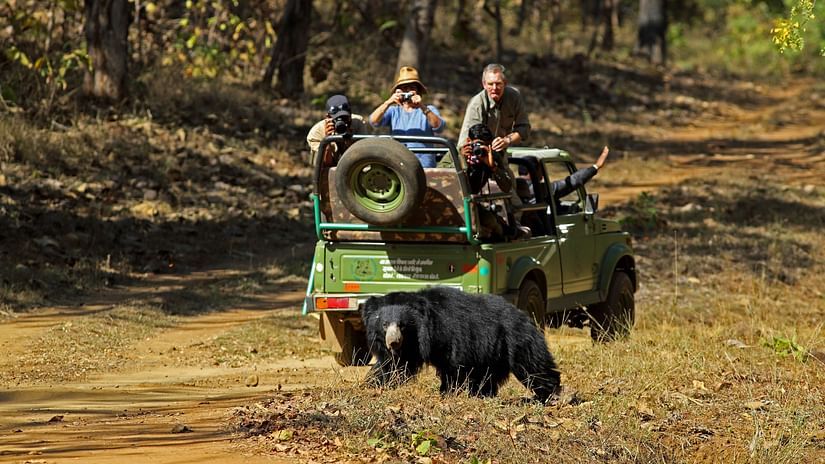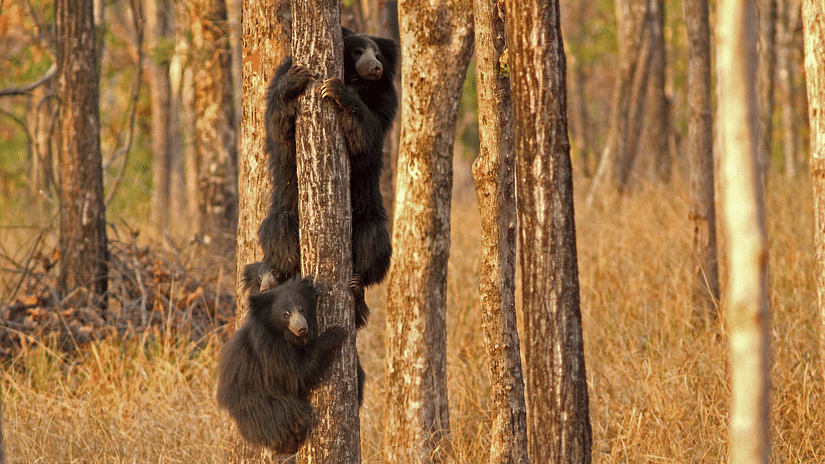- The White Lady Sings
- JEHAN NUMA’S “MAGNA CARTA” on its “HOSPITALITY ROOTS”
- Wild at Heart
- BHOPAL MON AMOUR
- Baloo the bear
- Bhopal: A neglected treasure
- Satpura – A magical wilderness
- Bhopal Through The Eyes of Time
- Satpura Safari
- Bhopal: A Neglected Treasure
- Exploring the Wilderness of Madhya Pradesh
- Farm to Soul
- Tribes of Madhya Pradesh
- The Reign of the 4 Queens of Bhopal
- Bhimbetka Caves - Glimpsing Into the Past
- Places to Visit in Satpura National Park

The sloth bear, Melursus ursinus is one of the most interesting animals of the Central Indian forests. It inspired the character “Baloo the bear” in Rudyard Kipling’s Jungle Book. This species gets its interesting name because it was mistaken to be a sloth by western explorers. However, it is neither slothful nor is it a sloth, it is very much a bear and is one of the 4 bear species found in India. It is the only bear species in India that is endemic to the Indian subcontinent and the only bear species in the world that carries its young on its back. Its eating habits are peculiar too, for an animal that can weigh up to 140 kilograms, it primarily feeds on ants, termites and seasonal fruits. So many facets, yet this star species barely or “bearly” gets noticed.
In Saptura, the sloth bear has been one of the star species for the past decade ever since tourism started here. The Madhai region of Satpura Tiger Reserve has a healthy sloth bear population and viewing is easier because of them being habituated to tourist vehicles over years of observation. Although these animals are distributed in most forested patches across the country, they are very shy in most of their range and not commonly seen. They have enormous claws that they use effectively to dig for ants, termites and beetle grubs and large holes on the forest floor are tell tale signs that they are around. Sloth Bears are listed as vulnerable on the IUCN Red List mainly because of gradual habitat loss and degradation. Adult bears are solitary animals and usually have preferred home ranges that depend on availability of food, water and shelter. They are quite tolerant of other bears being in this area. Males and females look alike, size and weight being a distinguishing factor. Usually, they would pair up and mate in the summer with young being born in the winter after an eight-month gestation period. The female will den in rocky areas or bushy thickets and the young will remain in the den for at least 45 days to 2 months, after which she will slowly bring them out on her back. As the cubs grow, they start roaming on her back and will do so for the next 6 months after which they start emulating the mother and learning the intricate skills of procuring their seasonal food. They will remain with the mother for 2.5 years till adulthood and slowly disperse to lead a solitary life of their own.


They have a notorious reputation for human attacks. In Central India, these negative interactions escalate during the Mahua, Madhuca longifolia flowering season when both forest-dwelling communities and sloth bears are searching for the same product; the Mahua flower. Mahua has immense value for the indigenous people in Central India, the flower is collected and dried up to make a country liquor. Flowers also sell by the kilogram in the market, making it an enticing proposition for forest-dwelling communities to collect it. The sloth bear is also lured by these flowers with their irresistible nectar-filled aroma and flavour. The Mahua tree flowers in March and April, months that are characterized by hot days. So, people leave their homes in darkness before dawn to start collecting, and this is when the sloth bear is most active too. These common habits of man and animal sometimes lead to interaction. The sloth bear with its poor eyesight and hearing usually gets startled during such encounters and would generally stay away, but sometimes in self-defence attacks do happen. However, the true nature of sloth bears is not aggressive, in a habitat like Satpura, where there is no human disturbance, sloth bears can be observed for hours feeding on termites, ants and fruits, totally oblivious to its surroundings. It does not prey on other animals and neither do other animals commonly prey on it. A true live and let live attitude.

Sloth bears have been subjected to a cruel past in India. A nomadic community known as the Kalandar used to capture and tame these bears for dancing and entertainment. In their childhood, most people aged 30 and above in India would have come across these bears performing for entertainment. It is very encouraging that due to excellent work done by the government and NGOs like Wildlife SOS, this practice has been stopped and such bears have been rescued and placed in rehabilitation centres. The government and NGOs have also worked with the Kalandar community to provide them with alternate livelihood opportunities so that there is a holistic and long-term solution to the dancing bear problem.


As depicted above the sloth bear is an animal with an illustrious natural history and a great character. It is surely one of the most interesting animals to see in the forests of Central India and Madhya Pradesh. Satpura National Park and Bori Wildlife Sanctuary are two of the finest places to see the sloth bear in the wild.
- Aly Rashid,
Director and Field Naturalist, Jehan Numa Wilderness





